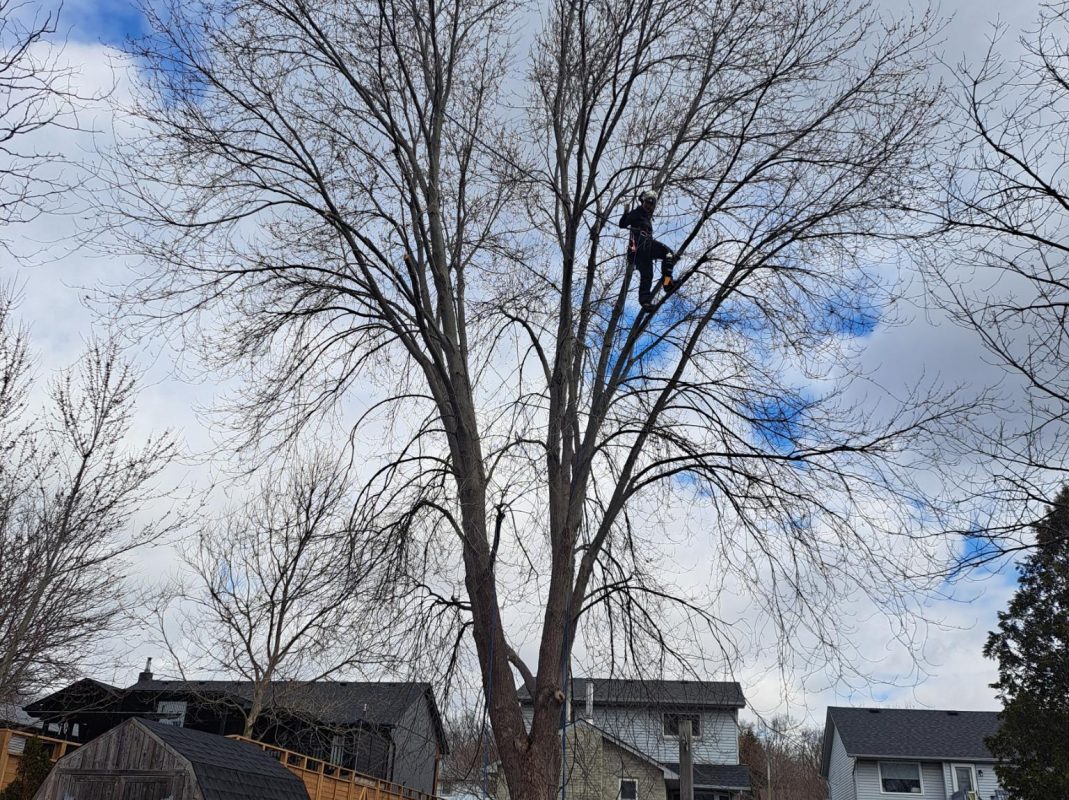
Welcome Spring!
With the return of spring we all start to turn our attention back to our yards and begin to make plans for the summertime where we hope to enjoy these spaces.
Now is the time to get in touch about planting new trees and shrubs. It is also a good idea to take a look around and see if the winter weather had any ill effects on your trees.
If you would like some help opening your property for the season, our team would love to come out and do a spring clean up for you!
Spring Fungamentals Workshop Series
Here is some feedback that we received about our March workshop: Fungamentals 1 – Mycology for Arboriculture and Urban Forestry
“I can take home valuable information that I can use at work and my personal life…Great presentation, thank you!”
“I learned how to ID mushrooms, what to look for in terms of danger signals for an arborist climber, and how to describe to a client what is happening to their tree.”
“At first I was worried I would not understand the terminology but Kyle and Charlie made it really easy to understand; very well organized”
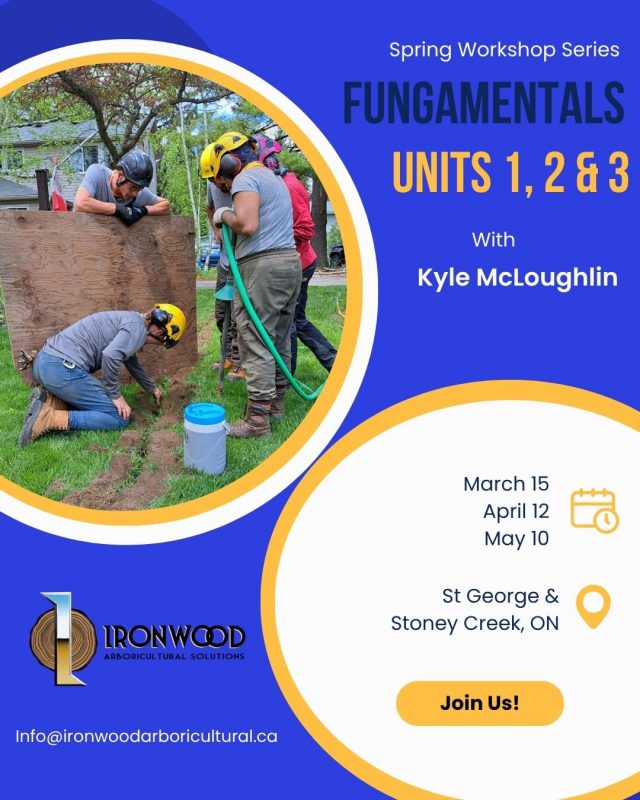
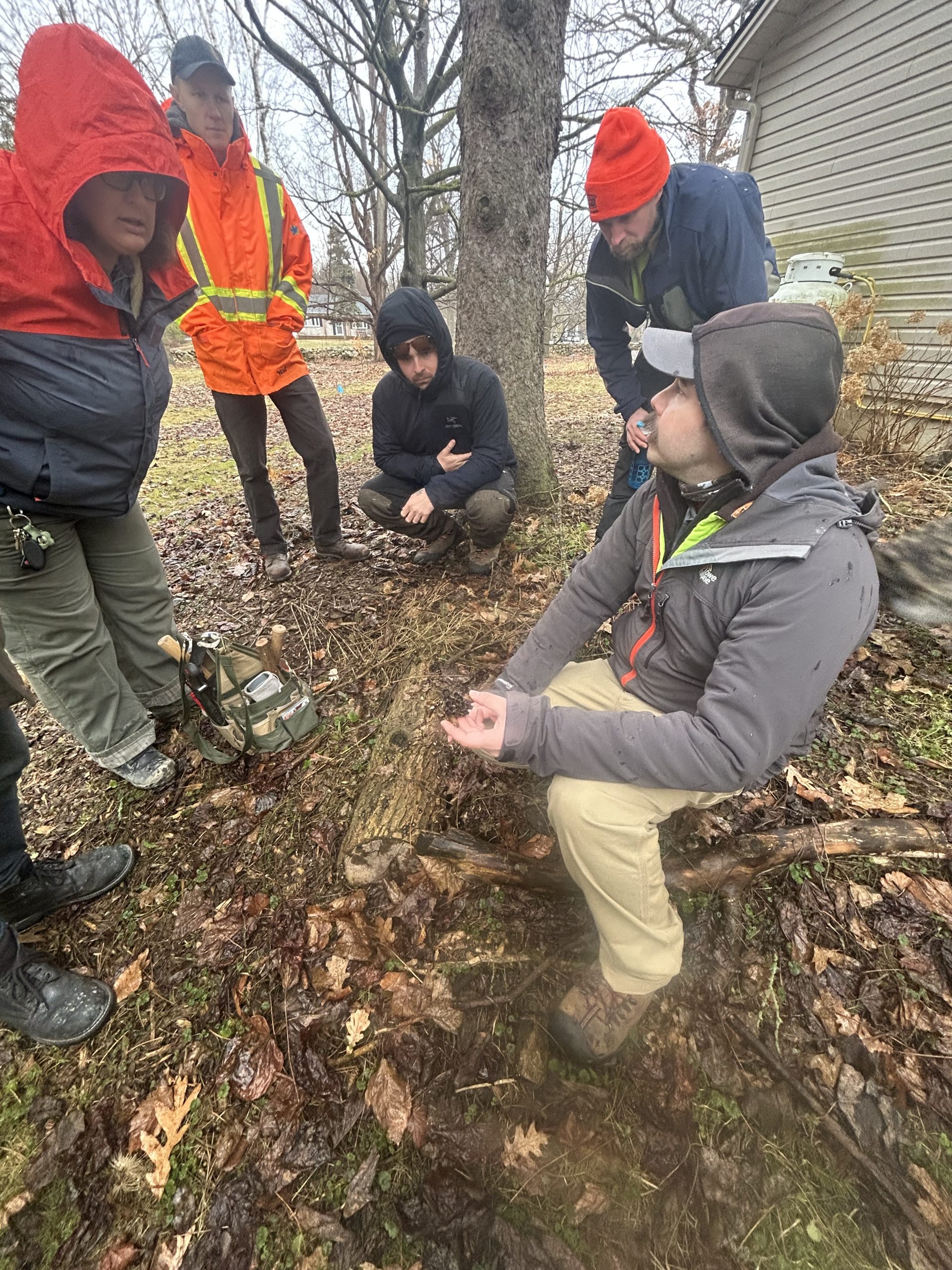
April 12 & May 10 Workshops
Designed for arborists and tree care professionals, these three full-day workshops in our Fungamentals series go in-depth into the interplay of trees and fungi and the importance of having this knowledge in our industry. Our remaining workshops for this spring:
 Fungamentals 2 – Small Tree Planting Pruning and Preservation
Fungamentals 2 – Small Tree Planting Pruning and Preservation
Saturday, April 12 in St George, ON
$245+HST – 5 spots available
Ensuring vigor and good structure into maturity is a common goal of arborists. That said, it doesn’t always happen. This workshop focuses on reintroducing the tree lover to different stock sizes, how to inspect stock, and what, if any, pruning should be done in the years following planting. Fungi covered include ones that kill cambium, ones that stress fruit trees, and understanding how to use fungal fertilizer at the time of planting.
 Fungamentals 3 – Practical Root Management and Air Excavation
Fungamentals 3 – Practical Root Management and Air Excavation
Saturday, May 10 in Stoney Creek, ON – 6 spots available
$285+HST
Air excavation is an ideal way to maximize tree life and learn what is happening below ground. Roots are the part of the puzzle most arborists trip over when dealing with plant health care and longevity. This workshop is meant to hone those skills by reviewing the operation of air excavation equipment, how it can be applied to tree health, and what fungi to expect and beware of when undertaking this kind of work.
Winter Educational Recap
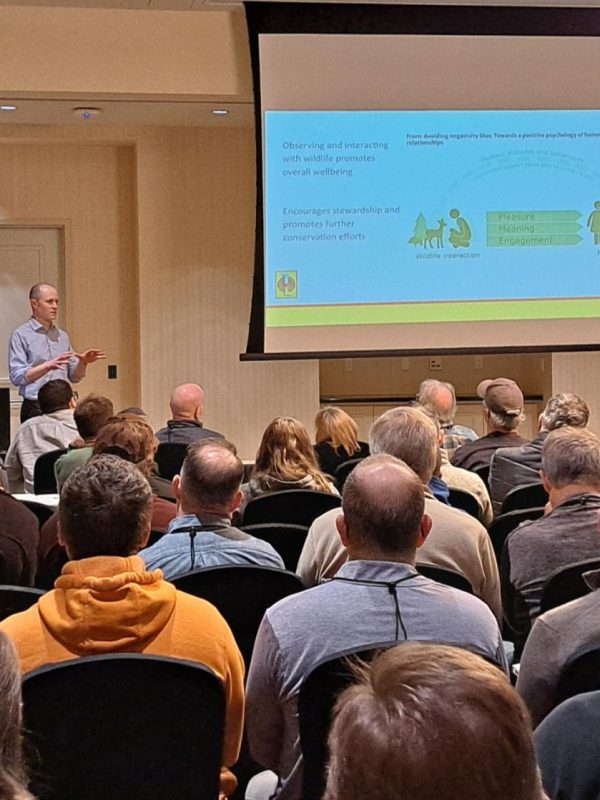

Winter is a slower season for operational work, which makes it an excellent time for arborists to catch up on training and educational events.
Both Kyle McLoughlin and Charlie Briggs presented workshops at the ISA Ontario Annual Conference and Trade Show in February, with Kyle focusing on bracket and conk ID, and Charlie delving into the importance of urban biodiversity. Charlie was also able to bring this workshop topic to a wider audience in March as a guest speaker for the Stoney Creek Garden Club and Horticultural Society.
We were also very busy working with Landscape Ontario by participating I the Annual Congress Conference, Pro Dev seminars, and IPM Symposium. Kyle was able to touch on a wide range of subjects from vascular pathogens to the theory behind root pruning.
CBC Radio
Kyle has been dubbed the “Resident Tree Expert” on CBC Radio’s Fresh Air program. His appearances for tree health call-in segments have become so popular that he has been moved to a monthly segment.
Next upcoming segments include:
- Saturday, April 5 at 8:30 am
- Saturday, May 24 at 8:30 am
- Saturday, June 28 at 8:30 am
Ontario Arborist Magazine
Kyle’s next article in the April/May edition of Ontario Arborist entitled “Tooth Decay and Other Toothy Fungi” will be the final article in his Decay Studies series. Look for a new series in Ontario Arborist, published by ISA Ontario, starting later in the spring!
Growing Degree Days & What They Mean
This year has started off comparatively slow to 2024, though faster than 2023, when it comes to the development of plants, insects and other life in our temperate region. Often only tracked at the start of April, the number of growing degree days so far accumulated since January informs us when to expect the blooms of our earliest flowering trees and shrubs.
Growing degree days are calculated by subtracting a base value temperature(5℃) from the mean daily temperature. So if the mean daily temperature of a spring day is 7℃, you would subtract the 5℃ to achieve a value of 2 growing degree days. A value of 0 is assigned if the number equalled is negative.
The total of growing degree days that have so far occurred since the beginning of the calendar year will allow for a rough idea of when to expect certain plants to bloom. This is because they require a number of warm spring days to reach this stage. The same is said for many insects that require a certain amount of heat to begin hatching from their overwintering eggs or stasis.
Definition of ‘Growing Degree Days’:
Growing degree days (GDDs) are used to estimate the growth and development of plants and insects during the growing season. Growing Degree Day are computed by subtracting a base value temperature from the mean daily temperature and are assigned a value of zero if negative. Base temperatures are a point below which development does not occur for the organism in question. Growing Degree Day products are created for base 0, 5, 10 and 15 degrees Celsius.
GDD values are only accumulated during the Growing Season, April 1 through October 31.
This spring has already been met with the blooms of our native silver maple (Acer saccharinum), introduced species of witch-hazels (Hamamelis sp.), and a mix of true hazels (Corylus sp.).
Paying attention to these natural events allows arborists to predict seasonal developments such as the time of leaf out and emergence of pests, which then dictate the appropriate times to apply practices such as pruning and integrated pest management controls.
As many of these events that occur with the warming season are linear year after year, as in ornamental cherry trees bloom before lilacs, we can guess the timing of upcoming events based upon those that have already occurred. This works between types of life as well, such as we can expect the eastern tent caterpillar (Malacosoma americanum) to hatch not long after the first blooms of male spicebush (Lindera benzoin).
Notice the stages of the trees around you and see what else you notice taking place in the natural world around you.
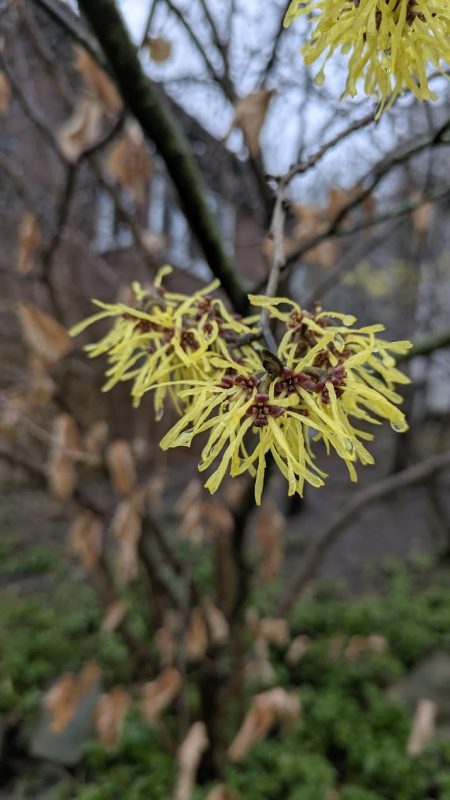

IQQQ – Ironwood Quarterly’s Question of the Quarter
Question from a colleague:
A client called about their apple tree. It’s not a fungus it’s a canker on an apple. The client wants to try and save it but the best I know is it’s apple canker. All I know is to prune back to good wood but it’s in the trunk. I can fertilize to improve the tree and make sure it’s watered. But you don’t know of anything like copper or something that would be beneficial do you? As far as I think it’s not a treatable canker?
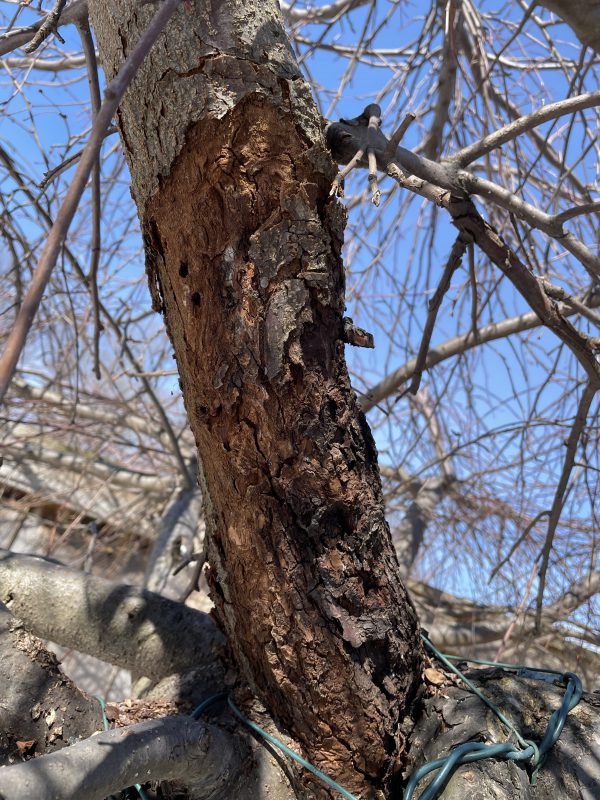
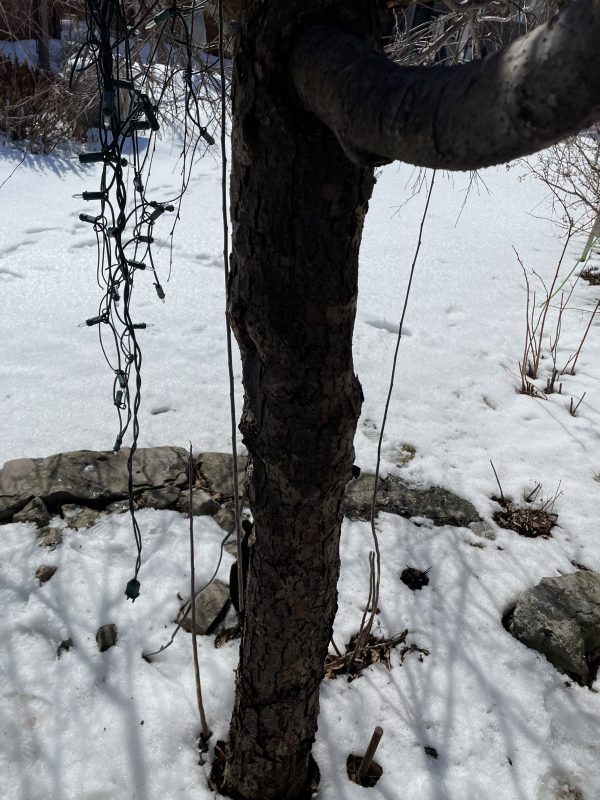
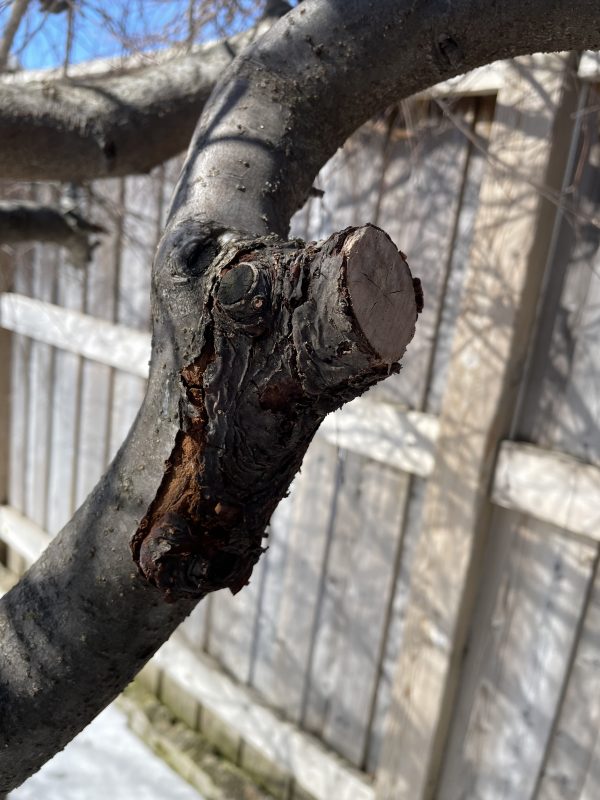
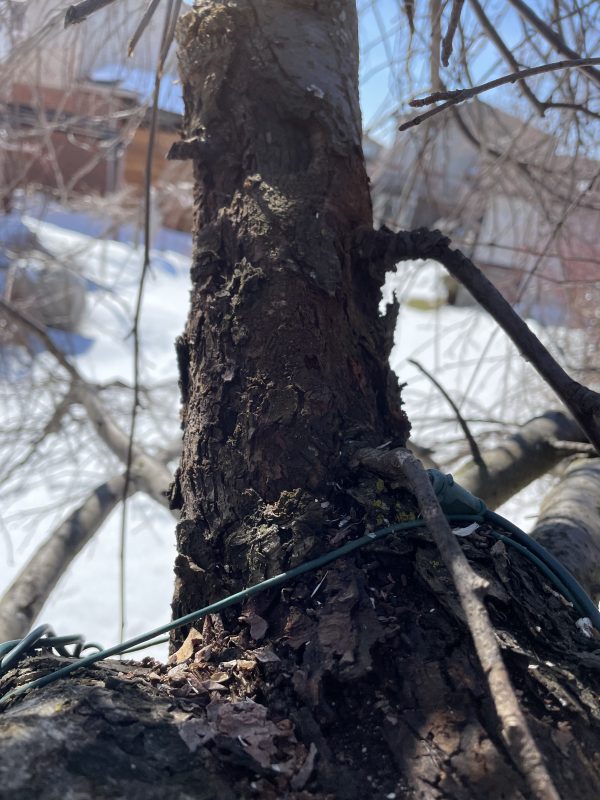
Answer:
Interestingly enough, most cankers are caused by fungi. In this circumstance, what you have is neither a canker nor fungi, but it is bacterial. Judging on the pictures and the species it looks like a manifestation of fire blight. Although it can be pruned out, it is HIGHLY contagious and can be transferred on your pruning tools to other parts of the tree. It can also be transferred to pears, peaches, cherries and mountain ash trees, any member of the rose family. One of the indicators during leaf out is brown, dry leaves that look like they have been burned by fire. Also look out for black patches on the bark as this is one of the effects of the disease.
The best thing you can do to help is to carefully prune out infected limbs and planning for a replacement tree. Bottom line: disinfect your tools between cuts with an alcohol based disinfectant spray.
Typically speaking, it is best to keep your trees healthy by mulching, and watering in the drought season. When watering it is best to use drip irrigation directly on the roots and not a sprinkler, as a sprinkler can help the disease spread.
Something else to watch out for – it is possible that this is not fire blight but flat headed apple tree borer. Check for emergence holes and larvae. Also it will be clear with insect galleries under the bark on dead limbs.